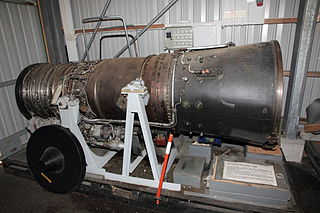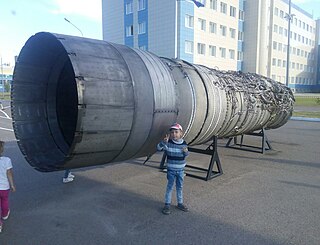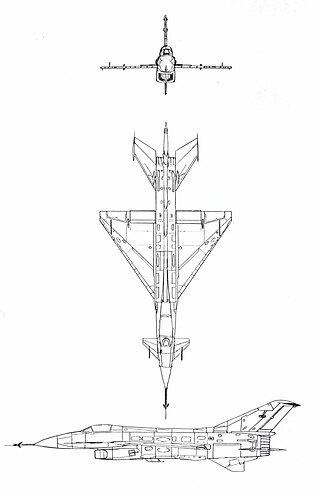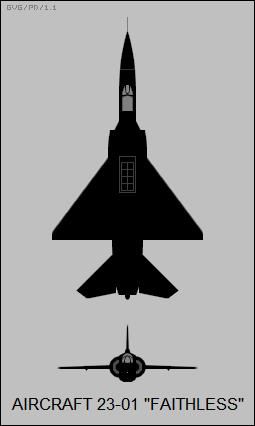
The Lyulka AL-21 is an axial flow turbojet engine created by the Soviet Design Bureau named for its chief designer Arkhip Lyulka.

The Soloviev D-30 is a Soviet two-shaft low-bypass turbofan engine, officially referred to as a "bypass turbojet". It is one of the most powerful turbofan engines developed in the Soviet Union. Development of the turbofan spurred numerous growth versions with increased fan diameter and modified component arrangements. Developed in a short period of time, the D-30 turned out to be one of the most reliable engines in the history of Soviet engine development, and it was recognized with the USSR State Prize.

The Tumansky R-11 is a Soviet Cold War-era turbojet engine.

The Tumansky R-13 is a Soviet turbojet engine designed by Sergei Alekseevich Gavrilov.

The Tumansky R-25 is a turbojet engine, which is seen as the ultimate development of Tumansky R-11. It was designed under the leadership of Sergei Alekseevich Gavrilov.

The Lyulka AL-7 was a turbojet designed by Arkhip Mikhailovich Lyulka and produced by his Lyulka design bureau. The engine was produced between 1954 and 1970.

The Tumansky RD-9 was an early Soviet turbojet engine, not based on pre-existing German or British designs. The AM-5, developed by scaling down the AM-3, was available in 1952 and completed testing in 1953; it produced 25.5 kN (5,700 lbf) thrust without afterburner. The AM-5 engine is notable for making possible the first mass-produced supersonic interceptors such as the MiG-19, and the first Soviet all-weather area interceptor, the Yak-25. When Sergei Tumansky replaced Alexander Mikulin as the OKB-24's chief designer in 1956, the engine was renamed RD-9. The engine was later built under license in China as the WP-6.

The Klimov VK-1 was the first Soviet jet engine to see significant production. It was developed by Vladimir Yakovlevich Klimov and first produced by the GAZ 116 works. Derived from the Rolls-Royce Nene, the engine was also built under licence in China as the Wopen WP-5.

The Tupolev Tu-123 Yastreb was one of the earliest Soviet reconnaissance drones that began development in 1960. Sometimes referred to as the "DBR-1", it was introduced into active service in 1964.

The Saturn AL-31 is a family of axial flow turbofan engines, developed by the Lyulka design bureau in the Soviet Union, now NPO Saturn in Russia, originally as a 12.5-tonne powerplant for the Sukhoi Su-27 long range air superiority fighter. The AL-31 currently powers the Su-27 family of combat aircraft and some variants of the Chengdu J-10 multirole jet fighter. Assembly of the engine is also performed under license in India by HAL, for the Sukhoi Su-30MKI. Improved variants power the fifth-generation Sukhoi Su-57 and Chengdu J-20.

The Kuznetsov NK-32 is an afterburning three-spool low bypass turbofan jet engine which powers the Tupolev Tu-160 supersonic bomber, and was fitted to the later model Tupolev Tu-144LL supersonic transport. It produces 245 kN (55,000 lbf) of thrust in afterburner.

The NK-8 was a low-bypass turbofan engine built by the Kuznetsov Design Bureau, in the 90 kN (20,000 lbf) thrust class. It powered production models of the Ilyushin Il-62 and the Tupolev Tu-154A and B models.

The General Electric YJ93 turbojet engine was designed as the powerplant for both the North American XB-70 Valkyrie bomber and the North American XF-108 Rapier interceptor. The YJ93 was a single-shaft axial-flow turbojet with a variable-stator compressor and a fully variable convergent/divergent exhaust nozzle. The maximum sea-level thrust was 28,800 lbf (128 kN).

The Kuznetsov NK-144 is an afterburning turbofan engine made by the Soviet Kuznetsov Design Bureau. Used on the early models of the Tupolev Tu-144 supersonic aircraft, it was very inefficient and was replaced with the Kolesov RD-36-51 turbojet engine.

The Kuznetsov NK-25 is a turbofan aircraft engine used in the Tupolev Tu-22M strategic bomber. It can equal the NK-321 engine as one of the most powerful supersonic engines in service today. It is rated at 245 kN (55,000 lbf) thrust. The three shaft engine we call the NK-25 was designed in the years 1972–1974. It is made by the Soviet Kuznetsov Design Bureau.

The Mikoyan-Gurevich Ye-8 was a supersonic jet fighter developed in the Soviet Union, intended to replace the MiG-21. Only two prototypes were built in 1960–61. The original MiG-21's air intakes were moved under the fuselage, freeing up the nose where a larger and more powerful radar, able to deliver longer range air-to-air missiles, could be built in. Canards were built to both sides of the nose, in front of the cockpit,.
The Lyulka AL-5 was a Soviet axial compressor turbojet developed from the Lyulka TR-3 turbojet around 1950. It was flight-tested in a number of prototype aircraft, but was not accepted for production.

The Tumansky R-29 is a Soviet turbojet aircraft engine that was developed in the early 1970s. It is generally described as being in the "third generation" of Soviet gas turbine engines which are characterized by high thrust-to-weight ratios and the use of turbine air cooling.
The Tumansky R-21 was a Soviet turbojet engine of the 1960s. Used for development only, the project was canceled.

The Mikoyan-Gurevich 23-01, aka Izdeliye 92 and (erroneously) Mikoyan-Gurevich MiG-23PD, NATO reporting name Faithless, was a 1960s STOL fighter / attack aircraft, designed in the USSR, to fulfil a requirement for ground-attack and fighter aircraft able to operate from short runways.


















